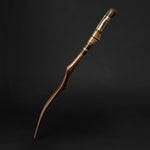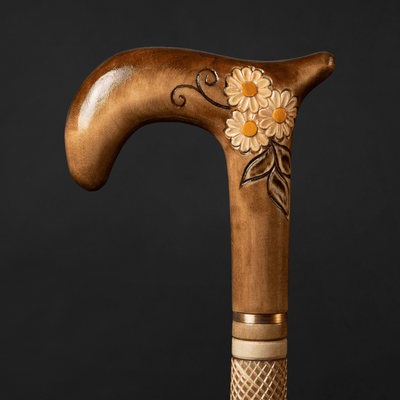You have no items in your shopping cart.
Recent Posts
-
Why an Elegant Cane Is a Thoughtful Gift for Loved Ones?
-
The Art of Christmas Design: Walking Canes That Celebrate the Season in Style
-
How an Ergonomic Walking Cane Handle Prevents Hand and Wrist Strain?
-
How to Walk With a Cane Correctly to Avoid Back or Shoulder Strain?
-
5 Common Mistakes People Make When Buying a Walking Cane (and How to Avoid Them)
-
How to Choose a Walking Cane That Reflects Your Personality (Not Just Your Needs)?
MOST POPULAR NOW
10
Dec
Walking canes have transcended their utilitarian origins to become iconic symbols of style, sophistication, and craftsmanship. In this exploration of classic canes, we delve into the artistry that goes into creating these timeless accessories. From the carefully selected materials to the skilled makers and intricate techniques, discover the craftsmanship that transforms a simple cane into a work of functional art.
The craftsmanship behind classic canes: materials, makers, and techniques
The choice of materials
1. Wood selection
Classic canes often begin with the careful selection of wood, a crucial factor in determining both the aesthetics and functionality of the finished product. Woods like oak, cherry, walnut, and mahogany are popular choices, each bringing its unique grain pattern and durability to the cane.

2. Handle materials
Handles are crafted from various materials to provide both comfort and style. Common handle materials include:
- Natural wood: Carved and polished for a classic, warm feel.
- Metal: Elegant and durable, metals like brass or silver can add a touch of luxury.
- Acrylic or resin: These materials allow for intricate designs and patterns.
3. Decorative accents
Classic canes often feature decorative accents that elevate their visual appeal. This can include metal collars, engraved bands, or even gemstone embellishments. These details not only add to the aesthetic charm but also showcase the artisan's attention to detail.
The makers and their expertise
1. Artisanal craftsmanship
Crafting classic canes is an artisanal process that requires skill, precision, and a deep understanding of the materials. Many canes are handcrafted by skilled artisans who bring years of experience to their work. This hands-on approach ensures a level of detail and quality that mass-produced canes may lack.
2. Customization and personalization
Craftsmen often offer customization options, allowing individuals to tailor their canes to personal preferences. This can include choosing specific wood types, handle designs, or requesting custom engravings. Personalization adds a unique touch to each cane, making it a truly individual accessory.
3. Artistic collaboration
Some classic canes involve collaborations with artists or designers. These partnerships result in limited-edition canes that merge traditional craftsmanship with contemporary artistic expression. Such collaborations often produce canes that are not just functional but also exquisite works of art.
Techniques in cane crafting
1. Wood carving
Wood carving is a fundamental technique in crafting classic canes. Artisans use various carving tools to shape the wood into intricate patterns, textures, or figurative designs. This technique allows for the creation of unique and visually appealing canes.
2. Metalworking
For canes with metal components such as handles or collars, metalworking techniques come into play. This includes shaping, welding, engraving, and polishing metal elements to achieve the desired aesthetic and functional qualities.
3. Finishing and polishing
The finishing touches are critical in bringing out the natural beauty of the materials used. Craftsmen employ polishing techniques to enhance the wood's grain, ensuring a smooth and lustrous surface. Clear coatings or finishes protect the wood and provide a long-lasting shine.
4. Joinery
Joinery techniques are essential for creating sturdy connections between the various components of a cane. Whether it's attaching the handle to the shaft or securing decorative elements, precise joinery ensures the cane's durability and structural integrity.
Conclusion
In conclusion, the craftsmanship behind classic canes is a fusion of art, tradition, and skill. From the careful selection of materials to the intricate techniques employed by skilled artisans, each step in the crafting process contributes to the creation of a cane that is not just a functional accessory but a testament to the enduring allure of craftsmanship.
Also Purchased
-
Beige Walking Cane for Ladies Chamomile Flower, Wooden Walking Stick
Introducing our beautiful Beige Walking Cane for Ladies with Chamomile Flower, a Wooden Walking Stick that is hand carved and handmade, making it both pretty and unique. This walking cane...$79.50 -
Exotic Burl Wood Walking Cane – Fashionable Artisan Stick
A sculptural statement in deep, oceanic blue — this walking cane is more than a support accessory, it's wearable art. Meticulously hand-shaped from stabilized burl wood, the handle evokes the...$425.00 -
ArtWalkingSticks™ MAGIC Walking Cane, Handmade - Make to Order
This piece of art is created for those who value details. We make one of a kind, handcrafted wood and resin canes. Our Wooden Canes are completely unmatched in creativity....$430.00 -
Umbrella with Eagle Handle, Fashion Umbrella For Men
Make a bold and fashionable statement with our Umbrella with Eagle Handle - a unique and functional accessory designed for men. The striking eagle handle is the highlight of this...$325.00 -
Fashionable Lion Shoehorn Long Handle, Pearly Brown Shaft, Handmade
Introducing our Fashionable Lion Shoehorn, a handcrafted, long-handled shoe horn with a pearly brown shaft that's both stylish and practical. The intricate Lion design adds a touch of elegance to...$240.00 -
ArtWalkingSticks™ MAGIC Red Walking Cane - Unisex, Handmade
This piece of art is created for those who value details. We make one of a kind, handcrafted wood and resin canes. Our Wooden Canes are completely unmatched in creativity....$425.00
































